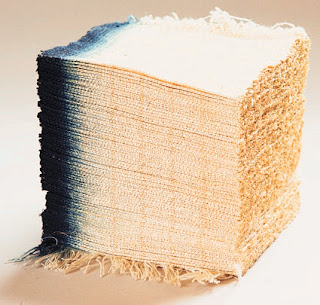As much as we loved the thatched-roof farmhouses, they were not our real reason for trekking to Miyama. Our main purpose was to visit Hiroyuki Shindo's indigo studio and his "Little Indigo Museum." Hiroyuki Shindo is a respected and highly accomplished indigo dyer and artist. He came across my radar for the first time 12 or 13 years ago when I visited the Brown Grotta Gallery in Connecticut. His large, translucent indigo-dyed panels hung quietly in the gallery but nearly bowled me over when I saw them. Amorphous shapes in deep blue stood in stark contrast to a pure, handwoven white linen background-- like huge indigo clouds in a bright sky. I later learned more about him from Textile Magicians, a wonderful documentary about 5 Japanese artists (three of whom we met on this trip). If you love art and/or textiles, I highly recommend it.
Shindo-San moved to Miyama 30 years ago after teaching for several years in the art department at Kyoto University. He chose Miyama because the quality of the water is conducive to indigo dyeing, and because of the availability of ash for fermenting the indigo. Although Miyama wasn't a tourist destination when he moved there, it became popular 20 years later. It wasn't long before people were knocking on his door to see his studio and his collection. He finally decided to open his "Little Indigo Museum" 5 years ago. We're so glad he did!
Shindo-San is a lovely, gregarious man and speaks very good English, which gave Chisako a welcome break from translating. He welcomed the four of us warmly, and started by taking us directly upstairs to the farmhouse "attic" to see the current collection on display. Here are a few of several indigo textiles that were on display.
 |
| 20th century kimono, "sekka" (snowflake) design. The design is complex, but the technique is simple: wood shapes are clamped around the folded fabric, resisting the indigo dye. |
 |
| Handwoven, indigo -dyed "jeans", work wear for the fields. They are for someone very tiny! |
 |
| 19th century quilted (sashiko) fireman's coat with freehand paste-resist decoration (tsutsuguki). |
 |
And, finally, he served us coffee and showed us his indigo-textiles collection from his recent trip to Hungary.
Shindo-San's work is in the permanent collections of the Chicago Art Institute, the American Craft Museum, the St. Louis Art Museum, and the Stediijk Museum in Amsterdam. Here are some photos of his art:





KATE! This is amazing!!
ReplyDeletei almost just fell off my chair
ReplyDeletethe beauty!!!